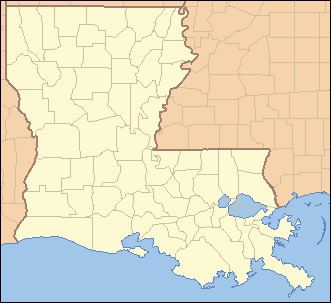- summer (DST) CDT (UTC-5) | Local time Sunday 7:19 AM | |
 | ||
Weather 22°C, Wind SE at 14 km/h, 92% Humidity | ||
Versailles is an unincorporated community in Saint Bernard Parish, Louisiana. It is along the East Bank of the Mississippi River, about 3.5 miles below the lower limit of New Orleans. The community, for governmental and postal address purposes, is considered part of Chalmette and by some designations, part of neighboring Meraux. The name "Versailles", as a place designation, continues in local use.
Contents
Map of Versailles, Chalmette, LA 70043, USA
History
Versailles was founded by Major-General Pierre Denis de la Ronde (1762-1824), Louisiana's wealthiest plantation owner. Denis De La Ronde was the commander of the Louisiana militia at the Battle of New Orleans, which was fought at the neighboring Chalmette plantation, belonging to his maternal half-brother, Ignace Martin de Lino de Chalmette (1755-1815). Paternally, both were also grandsons of French Canadian Judge and poet, René-Louis Chartier de Lotbinière of Nouvelle-France, and uncles of Micaela Almonester, Baroness de Pontalba who, in the 1840s, had the famed Pontalba Buildings in New Orleans constructed and, in 1855, completed the Hôtel de Pontalba in Paris.
In 1802, Denis de La Ronde was appointed to Louisiana's governing authority, the Cabildo. In 1805, with other local investors, he made plans to build Versailles along the Mississippi River and to then cut a barge canal through some dozen miles of swamp to the shore of Lake Pontchartrain, where they planned to build another town, called Paris. The intended communities were named after Paris and Versailles in France and were meant to recreate the French style. Denis de La Ronde envisioned that this Versailles would overtake New Orleans in size and popularity.
However, development was waylaid by political unrest, culminating in the War of 1812. Versailles remained a small town for the rest of the 19th century, with no navigable canal linking the River and the Lake until the Industrial Canal was built in New Orleans during the 20th century. Denis de La Ronde's path through the swamps fared better, eventually developing into a major artery, and Paris Road remains the farthest downriver route connecting the River to the Lake in Greater New Orleans.
Considered the most stylish plantation home in that part of Louisiana at the time; the name Versailles is mistakenly distributed, misnaming the Denis de La Ronde plantation in Old Families of Louisiana, yet no evidence has materialized that his mansion home was ever referred to as Versailles. Denis de La Ronde, in 1783, planted an avenue of southern live oaks to commemorate his 21st birthday, which still stands, largely intact, as the La Ronde Oaks, though also widely mislabeled, as Versailles Oaks and Pakenham's Oaks. General Pakenham died from battlefield injuries in Denis de La Ronde's mansion, which the British had commandeered for their headquarters and hospital, while the Battle of New Orleans raged on, which Denis de La Ronde had played an integral role in planning for with Andrew Jackson.
The La Ronde plantation home was heavily damaged and looted by the British during the 1815 battle, then burned to the ground in 1876. The ruins of the plantation remain visible along Highway 46 in St. Bernard Parish, as does the live oak tree avenue that once graced the path from the Mississippi River landing to the manor house.
